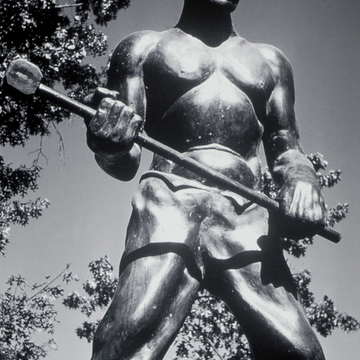John Henry is West Virginia's folk hero. His epic is intimately bound with the state's development and represents the eternal struggle between man and machine, a contest as appropriate now as ever in West Virginia, where machines have taken over so much work formerly the province of man. An early verse of the ballad sets the stage:
John Henry was a very small boy Sitting on his daddy's knee, Said, “The Big Bend Tunnel on the C. and O. Road, Is gonna be the death of me, Lord, Lord, Is gonna be the death of me.”The Big Bend tunnel, known officially as the Great Bend Tunnel, was one of the engineering triumphs of the Chesapeake & Ohio as it wended its way through West Virginia in the 1870s. The mile-and-one-quarter tunnel was begun in February 1870, and when it was completed in the fall of 1872, it was said to be the longest railroad tunnel in the country. It shortened the line's distance several miles by avoiding the meandering path of the Greenbrier River around the southern foot of Big Bend Mountain. John Henry, one of the laborers, was determined to prove he could best the “newfangled” steam drill in excavating for the tunnel:
Whether he died at the tunnel or at home “with his woman, Julie Ann,” depends on the variation of the ballad being sung. At any rate, all versions agree that John Henry did indeed beat the steam drill, but that it cost him his life:
John Henry got a thirty pound hammer, Beside the steam drill he did stand. He beat that steam drill three inches down, And he died with his hammer in his hand, Lord, Lord, He died with his hammer in his hand.Exactly one hundred years after the tunnel was completed, John Henry returned in the form of a larger-than-life statue. Before being placed on its pedestal above the portal of the tunnel, the statue was taken through the tunnel on a flatbed railroad car. John Henry was back home.








